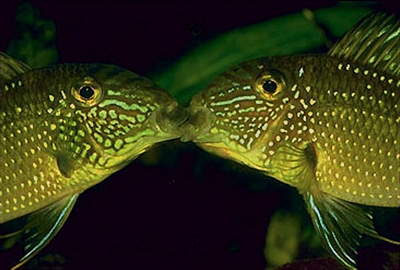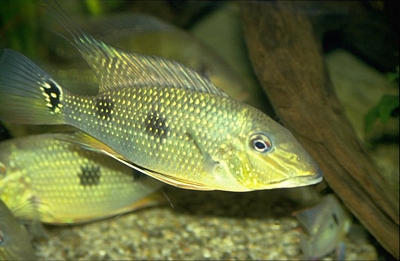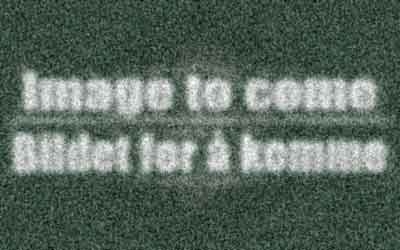Genus
Satanoperca,
Günther 1862
Text and photos by Alf Stalsberg,
unless otherwise indicated.
CLICK ON ANY IMAGE TO ENLARGE IT

Satanoperca was formerly included in Geophagus by Gosse in 1976, but rehabilitated by Kullander in 1986.
I guess the one Satanoperca we have had most of the time in our aquariums has been Satanoperca jurupari. Aquarists could see that we had at least two different Satanoperca jurupari types in our aquariums. But since we did not have another name, we called both types that we kept Satanoperca jurupari.
It was not until Dr Kullander rehabilitated the name Satanoperca in 1986, that we were aware that there were at least two different Satanopercas.
Satanoperca leucosticta
 |
Satanoperca leucosticta. |
I will start with Satanoperca leucosticta, and I will recommend you read the description of the fish in the book "The Cichlids of Surinam, Kullander & Nijssen, 1989". It's not only a good book, but even I as an amateur could get plenty of information. So if you look for scientific information (new) about Satanoperca leucosticta you'll find it here. It will save me some time and writing too.
The fish is found in Surinam, and probably also in British Guiana, Demerara. Satanoperca is found in collections from French Guiana (Kullander & Nijssen, 1989), but this fish is more similar to S. jurupari than to S. leucosticta.
There are some simple distinguishing marks we can see to determine if we are keeping S. leucosticta or S. jurupari. Satanoperca leucosticta is distinguised from all other Satanoperca species by the absence of dark blotches on the sides; preorbitals, cheeks and gill covers have numerous small whitish dots. There are some other differences too, but then you have to have dead specimens (Kullander & Nijssen, 1989). The fish spawn on the substrate and then take the eggs up in the mouth after about 24 hours.
I keep my fish at around 26°C and I feed them with all kinds of food: peas, shrimps, earthworms, mosquito larvae, and also flake food, Tetra Bits and Sticks. I have found out that these fish are not fussy about food. But one thing is very, very important: and that is a good water quality. I change half of the water in my tanks every week. If I don't do this, I'll get problems. I have learned the hard way, thinking that these rather "large" fish can go in a tank without changing water. I had a large external filter, which should do the cleaning. But we all know (not all of us, I'm afraid) that clear water is not necessarily clean water.
So changing water is more important than a large filter. Think about the natural evironment of these fish; most of them live in rivers. So what, you're probably thinking? Think again. Even when it's the dry season, most of the rivers carry water. It's a constant water flow, or in our terms, a constant change of water. If you would like to copy this, then the water should be coming into your tank at one end, and out the other. Then you need a large hotwater tank if your are not living in the tropics. Well, I don't.
I could, if I did not have anything else to do, change some of the water every day. This would be close to perfect, but I'm a little bit "lazy". Even if I want too, I can't, because I need to do some other things too. I'm married, have a house and kids, and I have to go to work every day. So I end up changing water once a week. But my fish seem to be happy, and it has been a long time since I last had hole-in-the head disease.
Satanoperca daemon
 |
Satanoperca daemon. |
Lorem ipsum dolor sit amet, consectetur adipiscing elit. Donec massa turpis, sollicitudin sed euismod quis, gravida nec elit. Curabitur orci massa, pellentesque a adipiscing vitae, dictum in augue. Mauris dui felis, porta ac venenatis ut, blandit a magna. Proin in velit ipsum, et tempor augue. Sed vitae leo ut nunc ullamcorper elementum et ac lacus.
Satanoperca acuticeps
 |
... |
Lorem ipsum dolor sit amet, consectetur adipiscing elit. Donec massa turpis, sollicitudin sed euismod quis, gravida nec elit. Curabitur orci massa, pellentesque a adipiscing vitae, dictum in augue.
Satanoperca jurupari
 |
... |
Lorem ipsum dolor sit amet, consectetur adipiscing elit. Donec massa turpis, sollicitudin sed euismod quis, gravida nec elit. Curabitur orci massa, pellentesque a adipiscing vitae, dictum in augue.
Satanoperca lilith
 |
... |
Lorem ipsum dolor sit amet, consectetur adipiscing elit. Donec massa turpis, sollicitudin sed euismod quis, gravida nec elit. Curabitur orci massa, pellentesque a adipiscing vitae, dictum in augue.
Satanoperca mapiritensis
 |
... |
Lorem ipsum dolor sit amet, consectetur adipiscing elit. Donec massa turpis, sollicitudin sed euismod quis, gravida nec elit. Curabitur orci massa, pellentesque a adipiscing vitae, dictum in augue.
Satanoperca pappaterra
 |
... |
Lorem ipsum dolor sit amet, consectetur adipiscing elit. Donec massa turpis, sollicitudin sed euismod quis, gravida nec elit. Curabitur orci massa, pellentesque a adipiscing vitae, dictum in augue.